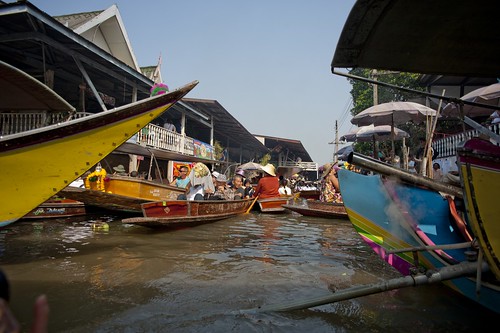Thailand is well known as a country to bag a bargain. The markets of Bangkok are a fascinating and exciting experience, where you can wander through the maze of stalls and take in the sights, sounds and smells of the city. If you are planning to fly to Bangkok, then schedule in plenty of time for shopping.
Chatuchak Weekend Market is a must visit, while others such as those in Patpong and Khlong Thom offer exciting night-time shopping experiences. For gifts you won’t find anywhere else, try one of the unique floating markets.
Chatuchak
Chatuchak Weekend Market is enormous and will challenge even the most seasoned shoppers. It is home to more than 8000 market stalls and you can expect it to be exciting and bustling as more than 20,000 visitors descend on the market to buy just about everything. To help you navigate your way through the maze there is a number system. Alleyways are labelled and the market is grouped into 27 sections. This can be a huge help when you want to remember a stall when shopping around and comparing prices.
Chatuchak sells pretty much anything you could ever want…ceramic pots, spices, shoes, lamps, jeans, paintings to name but a few, so you are bound to return with a stack of goods.
Pratunam
Pratunam clothes market is the best clothes and textile market in Thailand. Standing opposite the giant Baiyoke Tower, you will find a labyrinth of alleyways with clothes hanging all around the narrow lanes. You can pick up bargains that are being sold for much more in the department stores, but sizing is Thai rather different than western so it might not be easy to get the right fit.
Floating market
Bangkok had many floating markets because of the easy access of water transport, but due to development many of the waterways have disappeared. Two of the main floating markets still worth visiting are Damnoen Saduak and Amphawa market. Both are within two hours of the city and can easily be accessed on an organised trip or independently. It is a memorable experience to buy goods from a boat while you walk along the banks of a river.
Asiatique
Asiatique combines a night bazaar with a shopping mall. This busy complex has been created around a restored pier in what was once a bustling international trade port. It has now been developed to hold over 1500 boutiques and 40 restaurants as well as offering entertainment. It’s easier and much faster to arrive by boat as traffic can be hectic in the district. Most of the shopping is in large open buildings that have been designed to replicate enormous warehouses. It may be a little over the top, but as you will find a mixture of locals and tourists there it doesn’t feel too much like a tourist attraction.
Mini-guide to shopping in Thailand
If you are looking to explore Thailand’s markets, here are some top tips:
- Smile and be friendly when haggling; it’s likely to get you further.
- Wear comfortable shoes – you’ll be on your feet shopping for a long time.
- Travel to Bangkok with a half empty case so that you have room for your purchases.
- Check your goods thoroughly before purchasing to make sure there is no damage, especially with furniture and antiques.
- Don’t assume that anything in the market is genuine.
- Make a list of things you’re looking for before you hit the shops. Just be prepared to be lured into buying more than you bargained for!
- Take a bottle of water as it can get hot while you’re shopping.
- Protect yourself from the sun with sunscreen, a hat and sunglasses.
- Bring your own backpack with you to carry your purchases, although it is recommended that you either wear this on your front or you lock it so that it is kept secure.
- Don’t assume everything for sale in the market is being sold at a good price. You still need to do your research.
- Bring cash as many vendors don’t accept cards, although don’t store a large quantity of cash in one place on your person.
- Don’t take valuables with you like laptops or expensive cameras while out shopping.
- Go early and get your shopping out of the way before the crowds descend, or go late when it is cooler.
- Pick up a free map if one is available so you can mark where you see stalls you’d like to go back to when you’ve figured out what price is best.
- If you want to buy a number of items from one seller then you can usually get a special price.
Thailand has so many markets to explore. Whether you are looking for high end shopping malls or traditional bazaars, Bangkok is a fantastic shopping destination.
Editors Note: Today’s article was written and brought to you by Karen Bleakley. Karen enjoys travel in South East Asia and especially Bangkok’s many markets and shopping malls.
Photo Credit: Floating Market courtesy of flickr user jscoke via a creative commons license.














Recent Comments